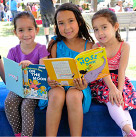Due to health concerns presented by the novel coronavirus, students of LA and San Bernardino County schools must begin the new school year remotely. Though distance learning will surely challenge parents and students, we at the Child Care Resource Center have some doctor-recommended tips for making the most of this safer home-based option.
One thing a physical school setting provides a child is structure. Students must arrive at school each day at a set time and move from class to class according to a specific schedule. Establishing a learning schedule at home can help keep your student focused on the coursework at hand. Dr. Damon Korb, a California member of the American Pediatrics Association, suggests designating clear cut periods for your student, such as spending time on science from 8:30 a.m. to 9:15 a.m. and math from 9:20 a.m. to 10 a.m.
Creating structure isn’t just for the “school day.” Dr. Richard Gallagher, a professor at New York University, advises getting your child to sleep at a time that reflects bed times of past school years. That also means making sure your child wakes up at a set time, brushes their hair and teeth, and gets dressed as usual. Dr. Gallagher believes sticking to a routing can help make learning from home still feel like a school day. You can find out more about building a routine by visiting the Strengthening Families blog.
We at CCRC know from experience with our childcare network that minimizing distractions is key to keeping your child focused on the work at hand. For older children, this may mean keeping their cell phone turned off or stowed away while they complete assignments. Younger children may be distracted by the TV or games on the computer, so experts recommend keeping the TV off if possible and installing parental controls on the computer to prevent game play or social media use.
Some families are considering homeschool pods, which are small group settings for their children to learn with nearby classmates. Integrating social interaction and collaboration can help prevent your child from getting lonely or frustrated. Parents who choose this option should consider the level of social distancing the other family has followed and how to continue health and safety practices in the home. This option may not be ideal for families with members who are at increased health risk or those who frequently encounter a lot of people outside the home.
Throughout the day of learning, it’s important for kids to take breaks and get some fresh air. Staying inside all day without much human interaction can be draining for kids who are used to seeing friends on the playground. Take some time out of the “school day” to go for a walk, play a game together, dabble in an art project, or cook a meal with your child. Check out our CCRC YouTube channel and our parent tab on the website for some fun learning activities to try with your child.
We know this unexpected transition to a remote learning situation is safer but it may also be confusing for kids. Make sure to help your child understand why they’re learning from home and explain COVID-19. Practice good hygiene and instruct your child on proper hand washing techniques. This change is a learning process for everyone, parents included, so try to be patient and don’t be afraid to swap ideas with fellow parents who are also going through this new experience.
Helpful links:
www.everyoneon.org has discounted internet options
www.khanacademy.org offers free video lessons in math, science, engineering, and art for kids k-12
www.ck12info.org is a good resource for free reading materials
Additionally, the Working Parent Resource Guide produced by Willis Towers Watson provides links to a number of different online learning tools that offer limited free trials.


